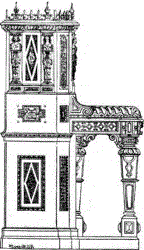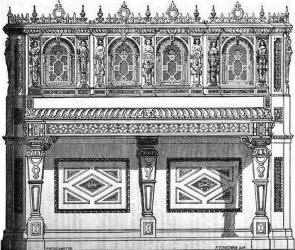home
| Pianoforte-makers
in England
ERARD
in
London ![]()

![]()
This, in conjunction with the longitudinal bars and the string-plate, form an entire metallic framing, extending from one end of the instrument to the other. Entire frames of metal have previously been used for upright instruments, and grands and Squares, with entire metallic frames, are exhibited by American and Danish manufacturers ; Messrs. Erard have, however, a patent for their peculiar method of application. We are inclined to fear that there is a growing tendency to use too much metal in the construction of piano-fortes. Up to a certain point it may, no doubt, be very valuable for its strength-giving powers; but there will probably be found a limit beyond which it may be injurious to the quality of the tone; it undoubtedly would be so if used to any extent in the violin tribe, whose resonance is produced in a way very analogous to that of the piano-forte. It must be considered also that so much metal adds greatly to the weight and the cost of the instrument, and diminishes proportionately its portability and general usefulness. Another full-sized grand, by the same house, 7 octaves, A to A, has a pedal clavier, similar to that of an organ. The pedal notes act on the lower notes of the piano, and have a Compass of about two octaves. This is not new, as organ builders and organ players have frequently adapted pedals to piano-fortes; and, some years ago, Messrs. Coventry and Hollier, of Dean-street, Soho, sold piano-fortes with pedals attached. We must say, however, that Messrs. Erard’s adaptation is superior to any former ones we have seen. Many of our readers probably know, that the attainment of proficiency in organ playing requires great practice with the pedal clavier ; and, since practising at churches is very inconvenient, it is obvious that an arrangement of piano-forte pedals for the chamber would be of service to organists ; but if, as we understand, the cost of the addition, as made by Messrs. Erard, amounts to nearly 30 or 40 per cent. extra on the price of the piano, we fear its use will be much circumscribed. A small upright, 7 octaves, A to A, by Messrs. Erard, differs in many respects from the ordinary English construction. In the first place, it has three strings to each note; whereas most English pianos of this kind have only two. Secondly, the strings, instead of being placed vertically, run obliquely across the instrument, by which a greater length is gained without increasing the height of the case. (This is a. very old plan, having been patented by Mr. Womum about 1810. The piano, thus made, was called the “unique,” and was the first low variety of the upright form. Several hundreds were made by the firm of Wilkinson and Womum.) Thirdly, it has a metallic bracing in front of the sound-board, on the same principle as that applied to the grand form. Fourthly, it is provided with a new repetition action, lately patented by this firm. Fifthly, it has a soft pedal acting in a peculiar way. The ordinary method of producing the soft tone in grands and uprights, is by shifting the action, so that the hammers strike only two strings instead of three, or one instead of two. Now this is inconvenient to accomplish where the strings run obliquely; and therefore the soft effect is here produced by interposing a piece of soft cloth between the hammer and the string, which deadens or softens the blow. It is an old French invention, and was
originally called the “jeu céleste” — its effect is pleasing; and it avoids
the tendency to throw the piano-forte out of tune, which is often the result
of giving the blow to one string. By applying the tuning key to turn this fixed screw, the nut attached to the string may be drawn or relaxed (according to the direction in which the tuning key is turned), and the pitch raised or lowered at pleasure. This plan is by no means new; it was adopted by a Mr.Lewis about a quarter of a century ago; and we have seen drawings and models of his instruments, shewing the arrangement precisely as now revived by Messrs. Erard. The evils of the ordinary wrest-pins are stated to be, that they require considerable force to turn, and become in time liable to slacken and let the piano-forte go out of tune. These are not of so much weight as is generally supposed; the latter objection, however, increases in importance, as the strings are made thicker, and the tension is consequently greater; and this is further enhanced by the heavier blows given in modern piano-forte playing. The ordinary friction wrest-pin is, it must he confessed, a primitive contrivance; but its extreme simplicity has retained it in use. If a firmer method, equally simple, could be devised, it would doubtless be an improvement ; but we do not think the plan exhibited by Messrs. Erard is the most advisable. There are other modes to be Seen in the Exhibition for attaining the same object; and we shall notice them in due course." Newton's London Journal of Arts and Sciences, 1851, p. 30-32
Various patented improvements in the mechanism, See., of pianofortes, are
displayed in the instruments exhibited by Mr. Erard, of which the following
is a description : —
British Department.
— 1.
Extra grand pianoforte, in walnut-wood, with carvings gilt; seven octaves, A
to A; with Erard's patent repetition action (1821); patent upbearing (1809);
complete system of metallic bracing (1825); and other improvements (1850).
See description in remarks.
— 2. Extra grand piano (1850), with pedal keys.
— 3.
Extra grand piano, with new patent metal wrest-plank (1850).
— 4. A short
grand, six and threequarters octaves, new scale, C to A; in a rose-wood
case, with nullings.
— 5. Extra grand walnut, oblique, with carvings in the
Elizabethan style; seven octaves, A to A; braced with four metallic bars
(1850). Action patented (1840).
— 6. The same, in ebony, inlaid with silver
(repetition action); also braced with four metallic bars (1850).
— 7.
Satin-wood; six and three-quarters; oblique. Patent of 1840.
French Department.
— 1.
Extra grand pianoforte, in tulip-wood case, inlaid with silver bands,
tortoiseshell, and brass, elaborately engraved, supported by 6ix caryatides,
in the most rich and elegant style; seven octaves, A to A. Patents of 1809,
1821, 1825, and 1850.
— 2. Extra grand pianoforte in rosewood, with or-molu
ornamenti; seven octaves, A to A.
— 3. Short, or semi-grand, with repetition
action (1809); six and three-quarters octaves, C to A.
— 4. Grand square
pianoforte, of a new form, with repetition action (1821), metal bracing
(1825), upward bearing (1809), on the principle of Erard's grand; six and
three-quarters octaves, C to A.
— 5. Grand oblique of seven octaves, braced
with tour metallic bars. Patents ol 1840 and 1850.
— 6. Oblique rosewood, with
or-molu mouldings: six and three-quarters octaves, C to A. Patent of 1840."
Reports by the Juries on the Subjects in the Thirty
Classes Into which the ..., 1851, p. 329
New patent pianofortes — ornamented extra-grand; extra-grand with pedal keys; small grand, improved new scale; grand oblique, ornamented in the Elizabethan style, adapted to extreme climates; grand cottage; reduced cottage; extra-grand and grand oblique. The plate 22 [shown in the left border] represents a front and side elevation of the Elizabethan pianoforte. New patent metal frames for pianofortes, intended to carry the principal part of the weight or pull of the wires, independent of the wood frame, with a new screw apparatus for tuning attached to the same; particularly adapted to extreme climates. Harps : — full and second size, newly improved; third size; highly ornamented; fourth size, adapted for young beginners. "Prince of Wales' harp" decorated. [The difficulty of keeping harps in order in extreme climates is greatly lessened by always placing them, when not used, in a common mahogany case. — H. E. D." Official description and illustrated catalogue of the Great exhibition, 1851, p. 469
Eines seiner Pianofortes war 6 Zoll breiter, als die gewöhnlichen, und hatte 7 Octaven Umfang (von A zu A). Die breitere Anlage geschah deshalb, um die Saiten etwas weiter von einander zu theilen und die Schwingungen der dieselben umgebenden Luftmasse dadurch mächtiger in Bewegung zu setzen. Sein Stutzflügel, "Short-grand" von 7 Octaven zeichnete sich ebenso durch klaren, edlen Ton aus, wie sein tafelförmiges Instrument, und an einem aufrechtstehenden Piano hatte Erard die Repetitionsmechanik an gebracht, deren er sich bei grossen Instrumenten bediente. Sein Pedal mit zwei Octaven Umfang erschien zur Ausführung Bach'scher Compositionen vorzüglich geeignet." Geschichte des Claviers vom Ursprunge bis zu den modernsten Formen dieses ..., exhibition 1851, by Oscar Paul, 1868, p. 160
The decoration of the case is gorgeous, and was carried out under the direction of Monsieur E. Guichard, of the Union Centrale of Paris. Other pianos by this celebrated firm are shown in the annexe. They are cottage pianos, of an expensive character, but present no novelties in construction. The marqueterie work of one of the cases is intricate and beautifully executed." Journal of the Royal Society of Arts, 1872, p. 890-891
Her Majesty Queen Victoria contributed a sine square pianoforte of the eighteenth century, and also a grand piano by Erard, which, though of modern construction, was interesting from an antiquarian point of view, on account of its decorations, the case being embellished with old French paintings on a ground of gold. " A Descriptive Catalogue of the Musical Instruments in the South Kensington ..., 1874, p. 359
|

